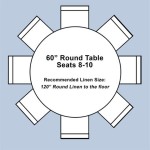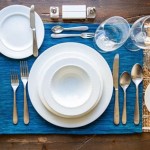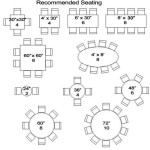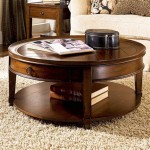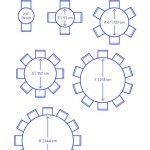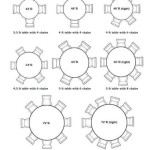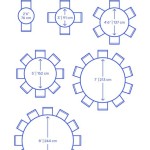Can You Use Placemats With A Tablecloth? Understanding Layering for Elegant Dining
The question of whether to use placemats with a tablecloth is a common one when setting a table. The answer, while seemingly simple, hinges on a variety of factors including the desired aesthetic, the occasion, the type of tablecloth and placemats being used, and the overall level of formality. Combining placemats and a tablecloth can indeed create a visually appealing and practical dining experience, but it requires careful consideration of design principles and functionality.
Historically, tablecloths served as a primary layer of protection for the dining table. They shielded the table from spills, scratches, and heat. As dining etiquette evolved, tablecloths also became a symbol of formality and elegance. Placemats, on the other hand, emerged as a more casual alternative, offering a smaller, more focused area of protection for individual place settings. The modern approach to table setting often involves a combination of both, blurring the lines between formal and informal arrangements.
Ultimately, the decision to use placemats with a tablecloth is a matter of personal preference and the specific context of the dining event. Understanding the advantages and considerations involved will allow for a more informed choice, resulting in a beautifully appointed and functional table.
The Benefits of Layering: Functionality and Aesthetics
Layering a tablecloth and placemats offers a blend of practical benefits and enhanced visual appeal. A primary advantage lies in the increased protection afforded to the table surface. The tablecloth acts as a general barrier against spills and minor damages, while the placemats provide an additional layer of defense directly under each plate and utensil. This dual protection is particularly valuable when using delicate or expensive table surfaces.
Aesthetically, layering allows for creating a more complex and visually interesting tablescape. The tablecloth provides a foundational color or pattern, while the placemats offer an opportunity to introduce contrasting colors, textures, or patterns. This can be particularly effective in coordinating with the overall décor of the dining room or the theme of a specific event. For example, a neutral-colored tablecloth paired with vibrant, patterned placemats can add a pop of color and visual interest without overwhelming the table setting.
Moreover, layering can add a sense of depth and dimension to the table. The different levels created by the tablecloth and placemats can elevate the dining experience, making it feel more refined and deliberate. This is especially noticeable with textured tablecloths and placemats, where the interplay of different materials can create a tactile and visually engaging surface. Consider a linen tablecloth paired with woven placemats for a rustic yet elegant feel, or a silk tablecloth with metallic placemats for a more glamorous and sophisticated look.
The functionality extends to ease of cleaning as well. Replacing and cleaning placemats is often easier than cleaning an entire tablecloth after a minor spill. Thus, placemats can minimize the frequency with which the tablecloth needs to be laundered, extending its lifespan. This is especially relevant for delicate or heavily embellished tablecloths that require special care.
Finally, layering can be used to subtly define individual place settings, even when using a single, large tablecloth. The placemat creates a visual boundary for each diner, helping to organize the table and make it feel more inviting. This is particularly helpful in larger settings where multiple courses are being served, as it provides a designated space for each element of the meal.
Key Considerations When Combining Tablecloths and Placemats
While layering a tablecloth and placemats can be aesthetically pleasing and functionally beneficial, several key considerations should be taken into account to ensure a cohesive and harmonious table setting. One of the primary factors is the coordination of colors and patterns. The tablecloth and placemats should complement each other, rather than clashing or competing for attention. This can be achieved through careful selection of colors that are either analogous (close together on the color wheel) or complementary (opposite each other on the color wheel). For instance, a blue tablecloth can be paired with placemats in shades of green or orange, respectively, depending on the desired effect.
The scale of patterns is also important. If the tablecloth features a large, bold pattern, it is generally advisable to choose placemats with a smaller, more subtle pattern, or even a solid color. Conversely, a plain tablecloth can serve as a backdrop for more elaborate placemats. Overly busy patterns on both the tablecloth and placemats can create a visually chaotic and overwhelming effect.
Material selection is another crucial aspect. The materials of the tablecloth and placemats should be compatible in terms of texture and formality. For example, a formal silk tablecloth might be best paired with placemats made of a luxurious material like velvet or linen, while a more casual cotton tablecloth can be paired with placemats made of jute, bamboo, or other natural materials. The weight and drape of the fabrics should also be considered to ensure that the placemats lay flat and do not slide around on the tablecloth.
The size and shape of the placemats should be proportionate to the size of the table and the place settings. Placemats that are too small may look insignificant, while those that are too large can overwhelm the table. The shape of the placemats should also complement the shape of the table. Rectangular placemats are generally suitable for rectangular tables, while round or oval placemats may be more appropriate for round or oval tables. Consider the overall dimensions of the table setting, including the plates, cutlery, and glassware, to ensure that everything fits comfortably on the placemat.
Formality is another important consideration. For formal events, a crisp, starched tablecloth and elegant placemats are generally preferred. For more casual gatherings, a relaxed linen tablecloth and less formal placemats can create a more inviting atmosphere. The choice of materials, colors, and patterns should reflect the overall tone of the event.
Alternative Approaches and Styles
While combining placemats and a tablecloth is a common and often effective approach to table setting, there are alternative styles and approaches that can be equally appealing. One alternative is to use a table runner instead of a full tablecloth. A table runner runs down the center of the table, providing a decorative element without covering the entire surface. Placemats can then be placed on either side of the runner, creating a visually balanced and elegant setting. This approach is particularly well-suited for tables with a beautiful wood grain or other attractive features that you want to showcase.
Another option is to use individual table squares or napkins underneath each place setting, instead of traditional placemats. These smaller pieces of fabric can add a touch of color and texture, while also providing a degree of protection against spills and stains. This approach can be particularly effective for informal gatherings or outdoor settings, where a more relaxed and casual atmosphere is desired.
A minimalistic approach involves forgoing both a tablecloth and placemats altogether, opting instead to showcase the natural beauty of the table. This style is particularly well-suited for tables made of high-quality wood or other attractive materials. In this case, coasters and trivets can be used to protect the table surface from heat and moisture. This approach requires careful attention to detail in terms of table maintenance and cleanliness.
Another style involves using chargers, which are large decorative plates placed under the dinner plate. Chargers add a layer of formality and elegance to the table setting, and can be used in conjunction with or without a tablecloth. When using chargers without a tablecloth, placemats are often omitted as well, allowing the charger to serve as the focal point of the place setting. However, chargers can also be combined with placemats on top of a tablecloth for an even more elaborate and formal look.
Finally, consider the use of unconventional materials for placemats. Beyond traditional fabric placemats, options include woven vinyl, cork, leather, or even reclaimed wood. These materials can add a unique textural element to the table setting and create a more personalized and distinctive look. The choice of material should be consistent with the overall style of the dining room and the theme of the event.

How To Set The Table With Placemats
The Great Debate Placemats Or Tablecloths Which Are Better Lc Studios

How To Use Placemats Ultimate Style Guide French Affair

How To Use Placemats Ultimate Style Guide French Affair

20 40 60 Etiquette Setting The Table Tone For Your Dinner Party

How To Match Tablecloth Napkins Runners And Placemats 4 Styles For All Occasions

Should You Use Placemats With A Tablecloth Combinations Positioning Tips Tablecoversnow Com

How To Set The Table With Placemats

Should You Use Placemats With A Tablecloth Combinations Positioning Tips Tablecoversnow Com

How To Buy The Right Tablecloth Or Placemats For Every Table And Occasion Cbc Life
Related Posts

